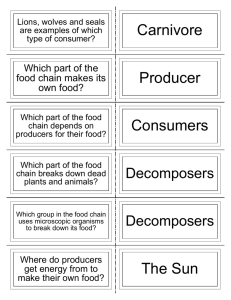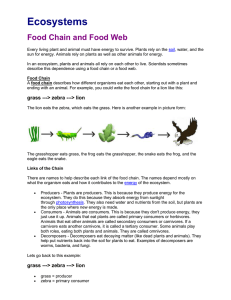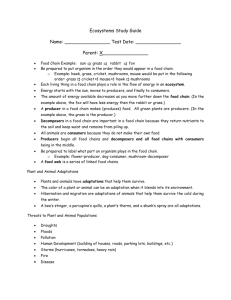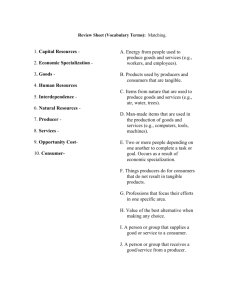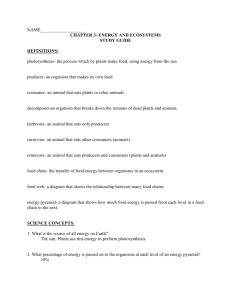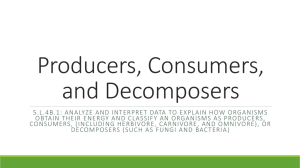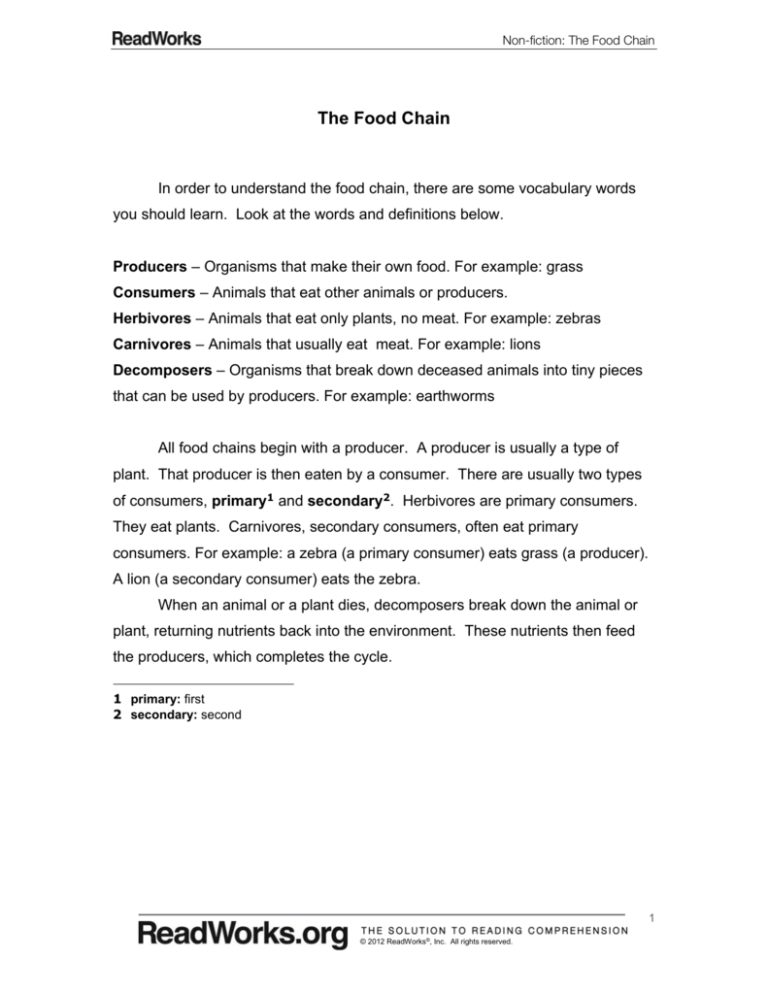
Non-fiction: The Food Chain
The Food Chain
In order to understand the food chain, there are some vocabulary words
you should learn. Look at the words and definitions below.
Producers – Organisms that make their own food. For example: grass
Consumers – Animals that eat other animals or producers.
Herbivores – Animals that eat only plants, no meat. For example: zebras
Carnivores – Animals that usually eat meat. For example: lions
Decomposers – Organisms that break down deceased animals into tiny pieces
that can be used by producers. For example: earthworms
All food chains begin with a producer. A producer is usually a type of
plant. That producer is then eaten by a consumer. There are usually two types
of consumers, primary1 and secondary2. Herbivores are primary consumers.
They eat plants. Carnivores, secondary consumers, often eat primary
consumers. For example: a zebra (a primary consumer) eats grass (a producer).
A lion (a secondary consumer) eats the zebra.
When an animal or a plant dies, decomposers break down the animal or
plant, returning nutrients back into the environment. These nutrients then feed
the producers, which completes the cycle.
1 primary: first
2 secondary: second
1
© 2012 ReadWorks®, Inc. All rights reserved.
Questions: The Food Chain
Name: ___________________________
Date: ______________________
1. The author lists vocabulary words
a.
b.
c.
d.
to give the reader more work.
to help the reader understand the passage.
to confuse the reader.
from the most important word to the least important word.
2. What is the difference between the two types of consumers?
a. Primary consumers eat plants. Secondary consumers often eat
secondary consumers.
b. Secondary consumers eat plants. Primary consumers often eat
primary consumers.
c. Secondary consumers eat plants. Primary consumers often eat
secondary consumers.
d. Primary consumers eat plants. Secondary consumers often eat
primary consumers.
3. __________ is an example of a carnivore.
a.
b.
c.
d.
Grass
A zebra
A lion
An earthworm
4. __________ is an example of an herbivore.
a.
b.
c.
d.
Grass
A zebra
A lion
An earthworm
5. Which part of the food chain is responsible for breaking down dead animals
into tiny pieces?
a.
b.
c.
d.
Carnivores
Herbivores
Producers
Decomposers
2
© 2012 ReadWorks®, Inc. All rights reserved.
Questions: The Food Chain
6. In a typical food chain, what would happen after a primary consumer eats a
producer?
________________________________________________________________
________________________________________________________________
________________________________________________________________
7. What is an effect of decomposers breaking down animals and plants after they die?
________________________________________________________________
________________________________________________________________
________________________________________________________________
8. Choose the word that best completes the sentence.
Nutrients from deceased animals and plants feed producers, _______ completes
the cycle of the food chain.
a.
b.
c.
d.
after
which
because
despite
9. Answer the following questions based on the sentence below.
In the savanna, when lions become hungry, they hunt for primary consumers
such as zebras in order to get rid of their hunger.
What? ___________________________________________________________
(do) What? hunt for primary consumers such as zebras
Where? _________________________________________________________
When (they become)? ______________________________________________
Why? ___________________________________________________________
10. Vocabulary Word: environment: everything that surrounds living things and
affects growth and health; the natural world.
Use the vocabulary word in a sentence: ________________________________
________________________________________________________________
3
© 2012 ReadWorks®, Inc. All rights reserved.
Answers: The Food Chain
Teacher Guide and Answers
Passage Reading Level: Lexile 620
1. The author lists vocabulary words
a.
b.
c.
d.
to give the reader more work.
to help the reader understand the passage.
to confuse the reader.
from the most important word to the least important word.
2. What is the difference between the two types of consumers?
a. Primary consumers eat plants. Secondary consumers often eat
secondary consumers.
b. Secondary consumers eat plants. Primary consumers often eat
primary consumers.
c. Secondary consumers eat plants. Primary consumers often eat
secondary consumers.
d. Primary consumers eat plants. Secondary consumers often
eat primary consumers.
3. __________ is an example of a carnivore.
a.
b.
c.
d.
Grass
A zebra
A lion
An earthworm
4. __________ is an example of an herbivore.
a.
b.
c.
d.
Grass
A zebra
A lion
An earthworm
5. Which part of the food chain is responsible for breaking down dead animals
into tiny pieces?
a.
b.
c.
d.
Carnivores
Herbivores
Producers
Decomposers
4
© 2012 ReadWorks®, Inc. All rights reserved.
Answers: The Food Chain
6. In a typical food chain, what would happen after a primary consumer eats a
producer?
Suggested answer: After a primary consumer eats a producer,
that primary consumer will be eaten by a secondary consumer.
7. What is an effect of decomposers breaking down animals and plants after they
die?
Suggested answer: Decomposers break down animals and plants
after they die, and it has the effect of returning vital nutrients back
into the environment.
8. Choose the word that best completes the sentence.
Nutrients from deceased animals and plants feed producers, _______ completes
the cycle of the food chain.
a.
b.
c.
d.
after
which
because
despite
9. Answer the following questions based on the sentence below.
In the savanna, when lions become hungry, they hunt for primary consumers
such as zebras in order to get rid of their hunger.
What? lions
(do) What? hunt for primary consumers such as zebras
Where? in the savanna
When (they become)? hungry
Why? in order to get rid of their hunger
10. Vocabulary Word: environment: everything that surrounds living things and
affects growth and health; the natural world.
Use the vocabulary word in a sentence: answers may vary.
5
© 2012 ReadWorks®, Inc. All rights reserved.


